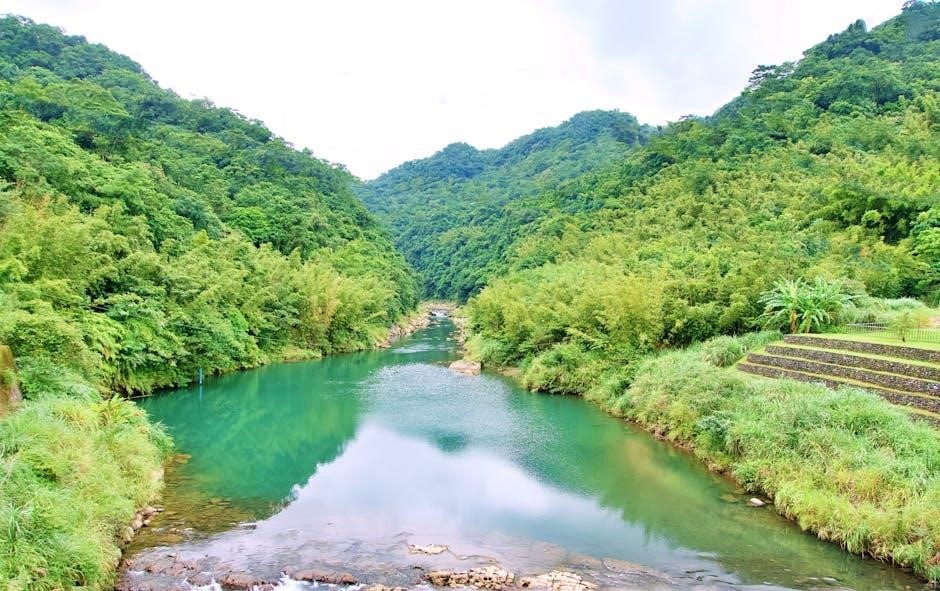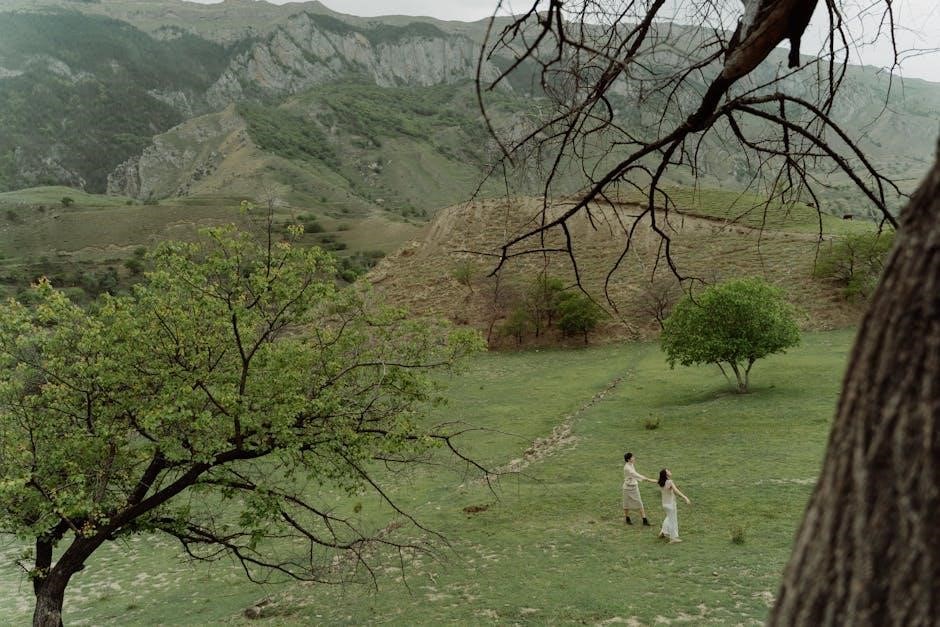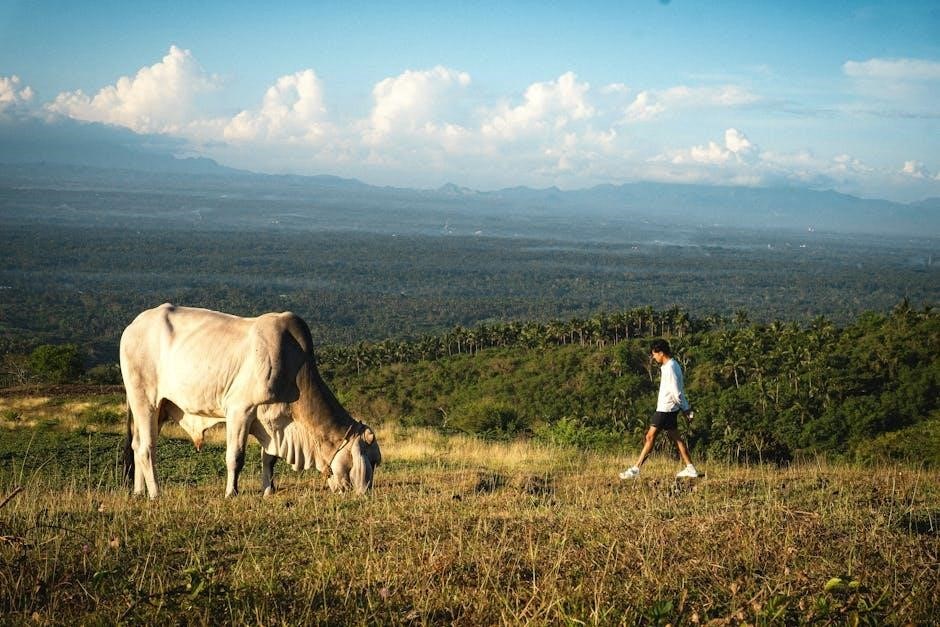Welcome to the ultimate guide for navigating your first year in Stardew Valley! This detailed walkthrough will help you set up your farm, balance activities, and thrive in this charming pixelated world. Learn how to optimize your daily routine, manage resources, and make the most of each season. Whether you’re a newcomer or aiming to improve, this guide provides a clear roadmap to success in Year 1 and beyond.
Overview of the First Year in Stardew Valley

Your first year in Stardew Valley is a foundational period where you establish your farm, build relationships, and explore the world. Starting with limited resources, you’ll focus on clearing land, planting crops, and upgrading tools. Spring is crucial for setting up your farm, while summer offers opportunities for fishing and mining. Fall brings harvests and preparation for the colder months, and winter shifts focus to indoor activities like cooking and crafting. Balancing daily tasks, managing time efficiently, and prioritizing goals will help you progress smoothly. By the end of Year 1, you’ll have a thriving farm and a strong connection with the community, setting the stage for future success.
Importance of Daily Planning
Daily planning is essential for making the most of your first year in Stardew Valley. Each day presents opportunities to progress, whether it’s planting crops, fishing, mining, or socializing. Without a clear plan, you risk wasting valuable time or missing out on key activities. By setting daily goals, you can efficiently manage your time, balance farm work with exploration, and ensure steady progress. For example, dedicating mornings to farming and afternoons to fishing or mining can maximize productivity. Planning also helps you prepare for upcoming events or seasonal changes, ensuring you’re never caught off guard. A well-structured routine will help you achieve your short- and long-term goals, making your first year in Stardew Valley both enjoyable and successful.

Spring in Year 1: Day-by-Day Breakdown
Day 1: Setting Up Your Farm
Start by clearing land, making a chest, and buying parsnips. Plant them alongside your initial seeds and keep forageables for food. Organize your farm setup.
Begin your Stardew Valley journey by claiming your farm and starting with the basics. On Day 1, focus on clearing land, making a chest, and organizing your space. Receive your free parsnip seeds from Mayor Lewis and plant them along with the 15 seeds you start with. Water all your crops and keep any edible forageables you find for food. Take a moment to interact with Willy to unlock fishing tools and explore the nearby areas. Check the weather and fortune for the day, though these won’t always impact your decisions. Prioritize setting up a functional farm layout to maximize efficiency in the days ahead.
Day 2: Fishing and Exploring
Start Day 2 by picking up your fishing rod from Willy at the beach. Head to the mountain lake to try your hand at fishing, focusing on catching trout or other early-game fish. Use this opportunity to explore the surrounding area, including the nearby forest and river. Keep an eye out for natural resources like wild herbs and berries, which can help manage your food and energy. Interact with the environment to familiarize yourself with the town’s layout and potential foraging spots. Fishing not only provides food but also helps build your skills and income. Don’t forget to check the weather and fortune for the day to optimize your activities.
Day 3: Upgrading Tools and Planting

Day 3 focuses on upgrading your tools and starting your farming journey. Visit Willy at the beach to upgrade your fishing rod, which will improve your fishing efficiency. Next, head to Pierre’s shop to buy parsnip seeds and plant them on your farm. Water your crops and ensure they’re well-tended. Use this day to organize your farm layout and begin crafting basic items like fences or scarecrows. Managing your resources effectively will help you maintain a steady income and set the foundation for future growth. Prioritize tasks that enhance your tools and farming capabilities, as these will pay off in the long run.
Day 4: Managing Resources and Crafting
Day 4 is all about managing your resources effectively and diving into crafting. Start by clearing debris from your farm to create space for future crops or animals. Use the materials you gather to craft essential items like fences or torches. Prioritize crafting tools that will improve your farming efficiency, such as a watering can or hoe. Visit Robin to upgrade your tools if possible, as this will save time and energy. Focus on balancing your resource gathering with crafting to ensure you’re prepared for the days ahead. Managing your resources wisely will help you maintain a steady income and improve your farm’s productivity. Keep track of your energy levels and plan your tasks accordingly to avoid burnout.
Days 5-10: Establishing a Routine
Days 5-10 are crucial for establishing a consistent routine that balances farming, resource gathering, and socializing. Start each day by watering your crops and tending to any new plantings. Dedicate time to clearing debris and organizing your farm layout for better efficiency. Allocate a portion of your day to fishing or mining to stockpile resources and earn gold. Begin interacting with villagers to build relationships and unlock new opportunities. Focus on managing your energy levels to avoid exhaustion, ensuring you have enough stamina for essential tasks. By maintaining this routine, you’ll create a strong foundation for future progress and ensure a smooth transition into the next phase of the game.

Summer in Year 1: Day-by-Day Breakdown
Summer in Stardew Valley is a bustling season filled with opportunities to maximize your progress. Transition smoothly from spring by preparing for summer crops, focusing on high-value plants like strawberries and melons. Allocate time for fishing and mining to gather essential resources and boost your gold income. Socializing with villagers becomes more important as relationships deepen, unlocking new quests and items. Manage farm expansion by upgrading tools and structures, ensuring efficient use of space. Balance farming, exploration, and community engagement to make the most of this productive season and set yourself up for long-term success in Year 1 and beyond;
Day 11: Preparing for Summer Crops
Day 11 marks the start of summer in Stardew Valley, and it’s crucial to prepare your farm for the upcoming season. Begin by clearing any remaining debris and organizing your farm layout to maximize space. Plant high-value summer crops like strawberries, melons, and pumpkins, ensuring they are watered and well-spaced. Check the weather forecast to plan your activities efficiently. Consider crafting or upgrading sprinklers to automate watering, saving time for other tasks. Allocate some time to fish or mine for resources, as these will be valuable in the coming weeks. Focus on building momentum by maintaining a balanced routine that prioritizes both farming and exploration.

Day 12: Focusing on Fishing and Mining
Day 12 is all about diversifying your income streams through fishing and mining. Start by visiting Willy to upgrade your fishing rod for better catches. Focus on fishing at the mountain lake or river, targeting high-value fish like trout or salmon. Mining is equally important—head to the Mines to gather ores and gems, which can be sold or used for crafting. Prioritize mining copper and coal to upgrade your tools later. Keep an eye on your energy levels and balance these activities with farm maintenance. Fishing and mining not only boost your gold income but also provide resources for future upgrades, making this day pivotal for long-term progress. Stay consistent and efficient to maximize your gains.
Day 13: Socializing with Villagers
Day 13 is dedicated to building relationships with Stardew Valley’s charming villagers. Start by checking the day’s weather and fortune, then head to the local hub to interact with townsfolk. Visit Pierre’s shop to gather information or buy gifts. Consider giving villagers their favorite items to boost friendship levels. Engage in conversations to unlock new storylines and items. Focus on key characters like Abigail, Leah, or Shane, as they offer unique rewards. Socializing not only enhances your in-game experience but also opens up new opportunities for items, quests, and even romance. Use this day to lay the groundwork for stronger connections and a more vibrant community life.
Day 14: Managing Farm Expansion
Day 14 focuses on expanding and organizing your farm for maximum efficiency. Start by clearing additional land to make space for more crops or future coops/barns. Upgrade your tools if possible, as this will save time and energy. Prioritize planting high-value crops like strawberries or melons, and consider placing scarecrows to protect them from crows. Use this day to plan your farm layout strategically, ensuring easy access to water sources and tools. Organize your inventory and chests to keep track of seeds, fertilizers, and other essentials. By the end of the day, your farm should be more spacious and better equipped to handle the demands of the upcoming season.
Days 15-20: Balancing Activities
Days 15-20 are crucial for establishing a balanced routine. Focus on maintaining your crops, ensuring they are watered and fertilized. Spend mornings tending to your farm, harvesting ripe crops, and replanting as needed. Afternoons are ideal for fishing or mining to gather resources and boost income. Dedicate some time to socializing with villagers, as building relationships can unlock new opportunities. Check your community center progress and work on completing any pending bundles. Use this period to explore new areas or upgrade tools if possible. Balancing farm work, resource gathering, and social interactions will set you up for long-term success and prepare you for the challenges ahead.
Fall in Year 1: Day-by-Day Breakdown
Fall brings harvests and new opportunities. Focus on reaping summer crops, planting fall staples like pumpkins, and optimizing your farm layout. Balance resource gathering, mining, and socializing to prepare for winter and achieve your goals.
Day 21: Harvesting Summer Crops
By Day 21, your summer crops should be ready for harvest. Focus on gathering your matured plants, such as corn, wheat, and sunflowers, to maximize gold income. Ensure your inventory is organized to store the harvested goods. Use this opportunity to clear space for fall crops, which will be planted soon. Additionally, check your farm’s layout to optimize efficiency and prepare for the upcoming season. Consider upgrading tools or crafting items to improve future yields. Managing resources effectively now will set you up for success in fall and beyond.
Day 22: Preparing for Fall Crops
Day 22 marks the transition to fall, and it’s time to prepare your farm for the new season. Clear any remaining summer crops and debris to make space for fall planting. Focus on obtaining seeds for fall crops like Cranberries, Eggplant, or Pumpkins, which offer high gold returns. Plant them in well-fertilized soil to ensure optimal growth; Organize your farm layout to maximize space efficiency and consider upgrading tools if needed. This preparation will set you up for a successful fall harvest and help you maintain a steady gold income throughout the season.
Day 23: Optimizing Farm Layout
Day 23 is all about optimizing your farm layout for efficiency and productivity. Start by evaluating your current setup and identifying bottlenecks. Consider consolidating crops, placing sprinklers strategically, and organizing fences to minimize wasted space. Ensure easy access to essential areas like the greenhouse, barn, or coop. Plan ahead for future expansions, such as adding animals or new crops. Clear unnecessary debris and arrange resources like chests or crafting stations for quick access. A well-organized farm reduces time spent navigating and allows you to focus on more critical tasks. This optimization will streamline your daily routine and improve overall productivity as you progress through the season.

Day 24: Increasing Gold Income
On Day 24, focus on boosting your gold income through strategic activities. Start by selling any mature animals, such as cows or chickens, to generate immediate profit. Consider upgrading your tools to improve efficiency in mining and fishing, which can yield higher-value resources. Plant high-value crops like Ancient Fruit or Cranberries if possible. Dedicate time to fishing in profitable spots, such as the beach or mountain lake, for rare fish. Additionally, explore the mines to collect ores and gems, which can be sold or crafted into valuable items. Prioritize these income-generating activities to maximize your gold earnings and set yourself up for long-term financial stability in Stardew Valley.
Days 25-30: Maintaining Progress
During Days 25-30, focus on maintaining and expanding the progress you’ve made. Continue tending to your fall crops, ensuring they are watered and fertilized for maximum yield. Regularly check your animals, collect their products, and keep their living spaces clean. Dedicate time to fishing and mining to replenish resources and increase gold income. Review your farm layout and make adjustments for better efficiency. Socialize with villagers to strengthen relationships and unlock new opportunities. Keep track of your gold earnings and adjust your activities to maximize profitability. By staying consistent and organized, you’ll ensure a strong foundation for the remainder of Year 1 in Stardew Valley.

Winter in Year 1: Day-by-Day Breakdown
Winter in Year 1 focuses on mining, fishing, and socializing. It’s a period for reflection and preparation, ensuring you maintain progress and are ready for Year 2.
Day 28: Preparing for Winter
Day 28 marks the transition to winter, requiring strategic preparation. Clear your farm of remaining crops and organize your inventory. Focus on managing resources like food and crafting materials. Ensure your tools are upgraded and ready for winter activities. Sell any unnecessary items to boost gold reserves. Prioritize planting winter-specific crops like Winter Roots or Brussels Sprouts if possible; Check the weather forecast to plan your fishing trips. Consider budgeting for a Greenhouse if feasible. Review your progress, complete any pending Community Center bundles, and stockpile food for the colder months. This day sets the foundation for a successful winter season.
Day 29: Focusing on Mining and Fishing
Day 29 is all about enhancing your resources and skills. Dedicate this day to mining in the Mines, focusing on reaching deeper levels to collect valuable ores and gems. Use your upgraded pickaxe and consider enchanting it for better efficiency. Spend the afternoon fishing at the Mountain Lake or nearby areas, aiming to catch high-quality fish for cooking or selling. Prioritize energy management to ensure you can mine and fish effectively. Use any spare time to craft essential items or upgrade tools. This day helps build your gold reserves and prepares you for future challenges in the game.
Day 30: Reviewing Year 1 Progress
Day 30 is your chance to reflect on your accomplishments and identify areas for improvement. Review your farm’s development, gold earned, and community center progress. Check completed bundles and remaining tasks. Assess your relationships with villagers and ensure you’ve unlocked key cutscenes. Evaluate your farming, fishing, and mining skills, noting what worked well and what didn’t. Use this time to organize your farm layout for better efficiency. Plan adjustments for the upcoming year, focusing on unfinished goals. This review helps you set realistic targets for Year 2 and celebrate how far you’ve come in Stardew Valley.
Day 31: Planning for Year 2
Day 31 is all about preparing for the challenges and opportunities of Year 2. Review your long-term goals and set clear priorities for the upcoming year. Focus on upgrading your tools, expanding your farm, and improving your skills in farming, fishing, and mining. Plan crop rotations for the next year, considering seasonality and profitability. Evaluate your relationships with villagers and identify who to romance or befriend further. Organize your resources and ensure your farm is optimized for efficiency. Set financial targets and consider future projects, like animal husbandry or advancing in the mines. This day is crucial for laying the groundwork for future success in Stardew Valley.
Additional Tips for Year 1 Success
Maximize gold by completing bundles, optimizing crops, and balancing activities. Focus on improving tools, building relationships, and exploring efficiently. Proper planning ensures steady progress and long-term success in Stardew Valley.
Maximizing Gold Earnings
To maximize gold earnings in Year 1, focus on high-value crops like parsnips and strawberries. Prioritize completing Community Center bundles for significant rewards; Fishing and mining can also generate steady income. Upgrade tools and use sprinklers to save time and boost efficiency. Regularly check the local market to sell items at optimal prices. Balancing farm work with exploration and crafting ensures a steady gold flow. By maintaining a well-rounded approach, you can accumulate wealth and prepare for future expansions and improvements in Stardew Valley.
Completing Community Center Bundles
Completing Community Center bundles is a key part of your first year in Stardew Valley. Each bundle provides rewards and unlocks new areas or features. Start by checking the requirements for each bundle in the Community Center. Prioritize bundles that align with your daily activities, such as fishing, farming, or mining. For example, the River Fish Bundle requires catching specific fish, while the Animal Bundle focuses on raising livestock. Use your journal to track progress and plan your tasks accordingly. Completing these bundles not only earns you gold and items but also helps restore the Community Center, a major goal in Year 1. Stay organized and focus on one bundle at a time to maximize efficiency.
Optimizing Farming Strategies
Optimizing farming strategies is essential for a successful first year in Stardew Valley. Start by prioritizing crops like parsnips, which mature quickly and provide a good return. Focus on upgrading your tools, especially the watering can, to increase efficiency. Invest in sprinklers early to automate watering, freeing up time for other activities. Plant crops in rows to maximize space and ensure proper growth. Rotate crops seasonally to maintain soil fertility and avoid depletion. Keep an eye on weather forecasts to plan planting and harvesting effectively. Regularly check your farm layout to minimize wasted space and improve workflow. By streamlining your farming practices, you’ll maximize yields, reduce waste, and build a strong foundation for future success. Consistency and planning are key to thriving as a farmer in Stardew Valley.
Mastering Fishing and Cooking

Mastering fishing and cooking is crucial for a thriving Stardew Valley experience. Fishing provides essential resources and cooking ingredients, while cooking boosts energy and health. Start by crafting a stove and experimenting with simple recipes like fried eggs or cheese soup. Prioritize upgrading your fishing rod and tackle to catch high-value fish like trout or salmon. Fish during optimal times and weather conditions for better catches. As you progress, unlock higher-level cooking recipes, such as crab cakes or pumpkin soup, which offer stronger buffs. Balancing fishing and cooking not only enhances your character’s abilities but also complements your farming efforts. These skills are vital for long-term success and add depth to your daily routine.
Year 1 is just the start! You’ve built a strong foundation. Keep optimizing routines, upgrading tools, and engaging with villagers to ensure continued success in Stardew Valley.

Final Thoughts on Year 1
Completing Year 1 in Stardew Valley is a significant milestone. You’ve successfully established your farm, built relationships, and explored various activities like fishing and mining. Reflect on your progress, celebrating accomplishments and learning from challenges. Year 1 sets the foundation for future success, so take pride in your achievements. By following a structured daily routine, managing resources effectively, and staying focused on goals, you’ve optimized your gameplay. Remember, consistency and adaptability are key to thriving in Stardew Valley. Use the lessons learned to refine your strategies for Year 2 and beyond. Keep experimenting, socializing, and enjoying the journey in this charming world!
Preparing for Future Success
As Year 1 comes to a close, it’s essential to reflect on your progress and plan for the future. Focus on upgrading tools and maximizing farm efficiency to ensure a strong foundation for upcoming years. Prioritize completing Community Center bundles to unlock new opportunities and rewards. Strengthen relationships with villagers to gain access to exclusive items and quests. Explore advanced farming strategies and invest in automation, like sprinklers, to save time. Keep experimenting with new crops, fishing spots, and mining areas to diversify your income streams. By staying organized and proactive, you’ll be well-prepared to tackle the challenges and opportunities that await in Year 2 and beyond.